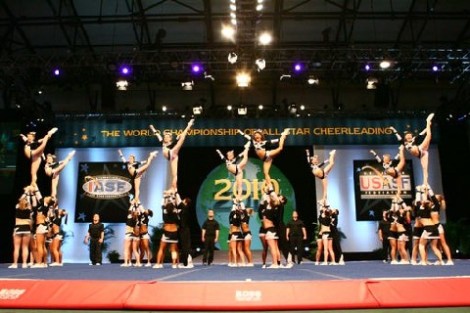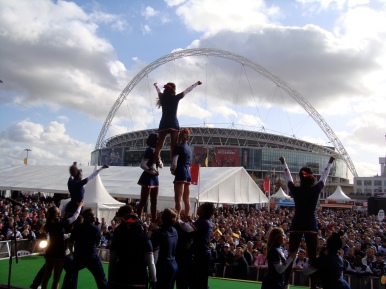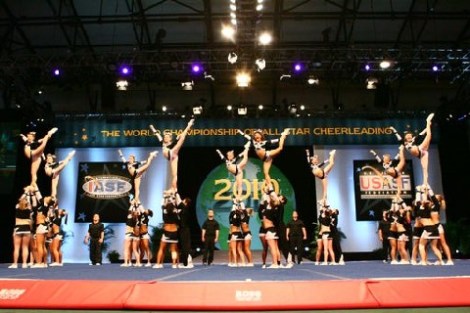This post has been re-published from www.luciebartlett.wordpress.com with kind permission of Lucie.

It is no secret to this blog that I’m a big advocate of cheerleading. As a former cheerleader myself – in support of our American football team at University, and competitively in London squads for the three years following – this is perhaps no surprise. I don’t pretend to offer an unbiased viewpoint, but I do hope to offer an informed one.
Long-standing has been the debate over whether cheerleading can be deemed a ‘sport’. Yesterday, in a strongly voiced opinion piece for The Guardian, Victoria Coren (daughter of Alan, brother of Giles, star poker-player) made her position on the point crystal clear. She’s entitled to her opinion, but I wanted to respond – if only to expand on the rantings from many a disgruntled cheerleader who posted some of the in response to the original piece.
What provoked Coren’s opinions was a news story that ran two weeks ago, presenting the latest statistics that show picked up by school P.E. departments across the UK. In a nation of growing obesity, where the inactivity of our children regularly hits the headlines, one would think the discovery of a discipline that engages children in this way would be celebrated. Apparently not.

(c) Ascension Eagles Cheerleaders
For me, focusing on the sport question tends to overlook the inherent values of the discipline, but more on that later. For now, let’s entertain the harshest critics for a moment and deal with the debate at hand, which requires two distinct definitions: firstly, which section of cheerleading is being referred to and secondly, the definition of sport being put forward.
Let’s talk about sport for a moment. The Olympics, generally considered the ultimate global representation of sporting excellence, makes a discernment between sports (a single or group of sports represented by an international federation) and disciplines (multiple events that can fall under the same sporting umbrella). Thus Aquatics is a sport, fielding activities in the disciplines, swimming, diving, synchronised swimming and water polo.
Now, don’t mistake me here, I am not for one moment purporting that cheerleading should be made an Olympic sport (or, for that matter, convinced that synchronized swimming should be classed as such either). But take a closer look at the IOC’s catalogue and you will find that not only is Gymnastics and its three disciplines (artistic, rhythmic and trampoline) on the official list of Olympic sports, but that ‘Dance Sport’, while not included in the Olympic program is fully recognized by the IOC and therefore could be added to the Olympic program at any given time if sufficiently supported by IOC membership vote.
What I am certain of is that competitive cheerleading represents the ultimate combination of Dance Sport and Gymnastics (artistic, rhythmic and, given the impact of a sprung floor on which all competitions are held, arguably trampoline). Just take a look at the most recent World Championship holders (for the fourth year in a row) and see if you disagree:
And this brings us to our second definition – what sector of cheerleading are we considering here? The competitive squads like the Stingray Allstars are a different kettle of fish entirely to the NFL dancer cheerleaders who bring glitz and sizzle to the football sidelines every Sunday and Monday night. But both have their value – on and off the field of performance. The point of the NFL girls on game day is to entertain the crowd – by their own admission they are first and foremost dancers – and do not enter into the gymnastic stunts of competitive cheer.
However, not even NFL cheerleaders should be cast aside with the aspersions so forthcoming from Ms. Coren in yesterday’s unfounded diatribe against cheerleaders the world over. NFL cheerleaders are a combined force of college students and professionals who give up their evenings, weekends and annual holidays to support their football team, fundraise for charity events, promote local businesses, teach cheer camps to local kids, entertain the forces abroad and promote their game around the world. Quite apart from the commitment to honed athleticism and the upkeep of physical excellence that is required to keep their appearance and performance up to the standard required.

NFL cheerleaders, New Orleans’ Saintsations, visit Kandahar Airfield in 2009
Whether their activities combined could be deemed a sport? Even I find that hard to argue. But to focus solely on the ‘ass-shaking’ of their poms in scantily clad costumes and over-sexualised dance numbers, is an easy observation to make, but is also a crass devaluation of their role and responsibilities.
But when it comes to the competitive cheerleading that I know so well, it is an entirely different story. It is a form of cheerleading that, sadly, seems to have escaped the research of Ms. Coren. I have seen firsthand this incredible discipline inspire thousands of youngsters to dedicate years of their lives to routines that display such athletic excellence – in the quite astonishing synchronisation of gymnastics and dance – that arguing the case for it to be classed a sport is, frankly, a pretty easy task.
Of course, British sensationalist press, the narrow-minded opinions formed from limited exposure to American high-school movies and a British viewpoint partial to condescension of our American cousins for their brash lack of culture means it is all too easy to make the ‘boots and hot pants’ picture the prevailing image of the cheer world. There follows the outrage of parents who (rightly so) find the concept of their child being taught to shake their booty in hotpants and boots quite horrendous. As would I, were that what was being taught in schools. Obviously, it isn’t.
And therein lies the problem, wrought by stereotype and informed by press exposure of the most commonly portrayed ‘cheerleader’ – that we overlook the athletic, competitive form that can indeed be classed as a sport.
Were these folks to turn up to any one of the several weekly training sessions of a UK cheer squad – national champions AEC a primary case in point – they would see a rather different world. Children who happily sacrifice listless evenings in front of the TV, weekends at the local park with friends; not to mention their adult coaching staff who volunteer their own spare time to inspire them – all in the name of athletic excellence.

AEC were selected to perform at last year’s NFL game at Wembley
Perhaps the solution is to take a lead from the IOC, deeming cheerleading as a whole to be a discipline, but discerning the divisions that fall within it – the sport, the competitive/gymnastic cheer (the likes of AEC and the Stingrays), and then the pom dance (the NFL variety) – a system of division that already effectively provides the structure for cheer competitions all over the country.
Cheerleading teaches them teamwork, trust and commitment and gives them a cause to focus on, learning that with enough dedication and practice, great outcomes can be achieved. And with this, combined with the tough athletic program that cheerleading requires, what more could we want to teach our kids?
Head down to Trafalgar Square on 30th October to see the 49ers Gold Rush in action ahead of the NFL International Series at Wembley on 31st.








